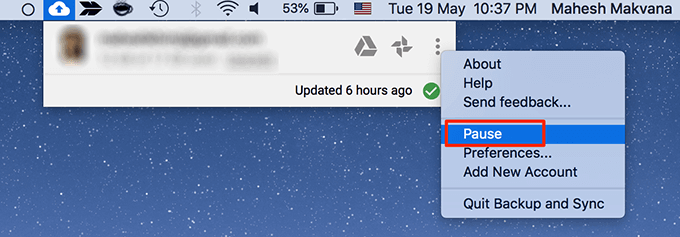


- HOW TO ADD GOOGLE DRIVE ICON TO MENU BAR ON MAC HOW TO
- HOW TO ADD GOOGLE DRIVE ICON TO MENU BAR ON MAC INSTALL
- HOW TO ADD GOOGLE DRIVE ICON TO MENU BAR ON MAC UPDATE
- HOW TO ADD GOOGLE DRIVE ICON TO MENU BAR ON MAC PASSWORD
- HOW TO ADD GOOGLE DRIVE ICON TO MENU BAR ON MAC DOWNLOAD
You do not need to sync any folders besides Google Drive.
HOW TO ADD GOOGLE DRIVE ICON TO MENU BAR ON MAC PASSWORD
Enter your Gmail or Google account (usually your email address) and password and click Sign In.
HOW TO ADD GOOGLE DRIVE ICON TO MENU BAR ON MAC INSTALL
Follow the steps to install from a disk image download.If you found it, click Google Backup & Sync and skip to 3 below. Click Launchpad (rocket icon) and look for Google Backup & Sync. Google Backup & Sync may already be installed on your computer. If it’s there, Google Drive is already running – see Accessing Files below.Ĭonfiguring Google Backup & Sync the first time
Look for the triangle-shaped Google Drive icon in your Mac’s menu bar.
HOW TO ADD GOOGLE DRIVE ICON TO MENU BAR ON MAC UPDATE
And you can even access the files when you’re offline – they update next time you have internet. You’ll always have the latest files… no matter where or who makes them. Any changes you make to the files are uploaded, and edits made on other devices update the files on your folder.
HOW TO ADD GOOGLE DRIVE ICON TO MENU BAR ON MAC DOWNLOAD
You should therefore check the size from time to time.ĭo you have simpler or alternative ways to view folder size on these and other platforms? Let us know in the comments section below.With the Google Backup & Sync app installed on your computer, all the files in your online Google Drive automatically download and sync with the Google Drive folder saved on your computer. These can grow rapidly and use up your storage space. There are folders automatically generated by apps you have installed. It is a good thing to know how big the folder you created is and the amount of disk space it is using.
HOW TO ADD GOOGLE DRIVE ICON TO MENU BAR ON MAC HOW TO
Now you know how to view folder sizes on different OS, platforms, and applications. The hidden folders will now appear in File Explorer on your PC.
This is because the files in the folder take up space in the “Filesystems table” where their name and properties are stored. In most cases, a folder can take up more space on disk than its actual size. Some show a graph, others show a pie chart or bars. These tools also provide intuitive size representation. There are also other additional tools to help you view the true size of a folder. The tool returns the true folder size because it doesn’t double count files that have multiple hard links. To view the actual folder size, you can use a du Tool such as Microsoft Sysinternals. Go to File Explorer > Click “View” > Select “Group By” > then choose “Size.”Īdditional FAQs How Do You View a Folder’s True Size?


 0 kommentar(er)
0 kommentar(er)
